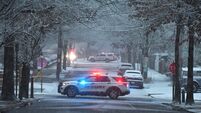Logistical nightmare as aid pours into disaster zone
The huge world relief drive to shelter, treat and feed millions of survivors of the Indian Ocean tsunamis finally kicked in today as the death toll passed 121,000 and was still climbing.
But with help streaming in, overstretched authorities were dealing with logistical nightmare of getting it to the needy.
Tons of supplies were backlogged in Indonesia, with thousands of boxes filled with drinking water, crackers, blankets and other basic necessities piled high in an aircraft hangar nearly 300 miles from Banda Aceh, the wrecked main city in Indonesia’s disaster zone.
Indonesia, the hardest hit nation, said its toll – now at 80,000 – could reach 100,000, and officials began to acknowledge that the number of dead may never be known with precision, because the towering waves that smashed into Sumatra island swept entire villages with their inhabitants out to sea.
On India’s Andaman and Nicobar islands, survivors were desperate for food and water, with Indian relief workers struggling to get them aid six days after the disaster.
“There is nothing to eat there. There is no water. In a couple of days, people will start dying of hunger,” said Anup Ghatak, a utilities contractor from Campbell Bay island, as he was being evacuated to Port Blair, capital of the archipelago.
Rescue workers in the archipelago believe thousands of uncounted bodies remain in the debris of crumbled homes, downed trees and mounds of dead animals on several islands. India has officially reported 7,763 dead in the tsunami disaster – most from the southern provinces of the mainland.
Only around 700 dead from the archipelago were counted, but officials said today more than 3,700 were still missing. An official a day earlier said 10,000 could be dead in the archipelago.
Forensic teams in Thailand packed bodies in dry ice as the government announced its death toll had doubled to more than 4,500 people, almost half of them foreigners who had been vacationing on the country’s renowned white-sand beaches.
After Indonesia, Sri Lanka was the next hardest hit, with about 28,500 deaths.
Parents lost children in the disaster were reported to be abducting orphans to replace them.
Somalia doubled its death toll to more than 200 today
Asian leaders were trying to put together a meeting next week in Jakarta that would group Asian countries with international donors and organisations.
Meanwhile, families around the Indian Ocean rim and beyond spent their sixth day of desperation trying to track down missing loved ones, including vacationers on the sunny beaches of Thailand, India and Sri Lanka.
Tens of thousands were still missing, including at least 3,500 Swedes, more than 1,000 Germans and 500 each from France and Denmark.
In Sri Lanka, where more than 4,000 people were unaccounted for, television channels were devoting 10 minutes every hour to read the names and details of the missing. Often photos of the missing were shown with appeals that they should contact their families or police.
On Phuket, people scoured photos pinned to notice boards of the dead and missing. Canadian tourist Dan Kwan was still hunting for his missing parents and refused to give up hope.
“At this point we hope against hope that they are still alive somewhere,” he said, adding that it was possible they were unconscious or unable to speak.
The search for loved ones on Sumatra was even less coordinated. One man was looking for his grandmother by checking corpse after corpse scattered over a road near her ruined home.














